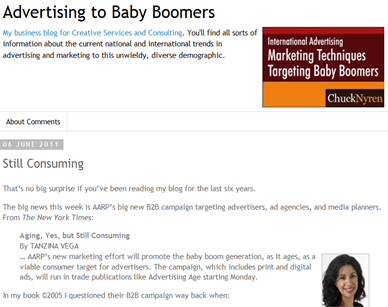That’s no big surprise if you’ve been reading my blog for the last six years.
The big news this week is AARP’s big new B2B campaign targeting advertisers, ad agencies, and media planners. From The New York Times:
Aging, Yes, but Still Consuming
By TANZINA VEGA
 … AARP’s new marketing effort will promote the baby boom generation, as it ages, as a viable consumer target for advertisers. The campaign, which includes print and digital ads, will run in trade publications like Advertising Age starting Monday.
… AARP’s new marketing effort will promote the baby boom generation, as it ages, as a viable consumer target for advertisers. The campaign, which includes print and digital ads, will run in trade publications like Advertising Age starting Monday.
In my book ©2005 I questioned their B2B campaign way back when:
NostraChuckus Predicts The Future of AARP
 … The advertising campaign has one ad with ashen-faced Baby Boomers in body bags ("These days, doctors don't pronounce you dead. Marketers do."). Another shows Baby Boomers acting like testosteroned teenagers ("Outta the way, punks: older racers are the hot-rod kings!").Yet another has one of a middle-aged lady dead in a powder room (probably from overdoing it on the dance floor) with police chalk outlining her body. I don't know what the copy is because I haven't seen it. It's probably something like, "Give me wrinkle cream, or give me death!"
… The advertising campaign has one ad with ashen-faced Baby Boomers in body bags ("These days, doctors don't pronounce you dead. Marketers do."). Another shows Baby Boomers acting like testosteroned teenagers ("Outta the way, punks: older racers are the hot-rod kings!").Yet another has one of a middle-aged lady dead in a powder room (probably from overdoing it on the dance floor) with police chalk outlining her body. I don't know what the copy is because I haven't seen it. It's probably something like, "Give me wrinkle cream, or give me death!"
© 2005 by Chuck Nyren and Paramount Market Publishing
 This one is better, although the execution is a tad bland. And I wonder why a profile or link to a recent AARP/Ad Age white paper is nowhere to be found:
This one is better, although the execution is a tad bland. And I wonder why a profile or link to a recent AARP/Ad Age white paper is nowhere to be found:
50 and Up: What's Next?
 The generation that defined youth marketing for Madison Avenue is readying for retirement. Here’s what they’re thinking, where they're spending their money and what marketers should know in order to reach them. Data from AARP's Baby Boomers Envision Retirement Survey, GfK MRI’s Survey of the American Consumer and Ad Age's MarketFinder.
The generation that defined youth marketing for Madison Avenue is readying for retirement. Here’s what they’re thinking, where they're spending their money and what marketers should know in order to reach them. Data from AARP's Baby Boomers Envision Retirement Survey, GfK MRI’s Survey of the American Consumer and Ad Age's MarketFinder.
Perhaps because the ad agency had nothing to do with it. Or an oversight in AARP’s marketing department. Download the AARP/Ad Age White Paper.
I wish AARP luck with their campaign. Convincing twentysomething ad agency folk to target anybody but themselves ain’t a cakewalk.

»
Update 8 June 2011:
Dick Stroud’s take on the campaign.
Imagine the possibilities of J.C. Penney in the future: An iPad enables one shopper to mix and match shirts and slacks without having to undress. A teen sends a mobile photo of a skirt to her father, who pays for it without leaving home by using his smartphone.
This weekend while at Costco, I caught a grandmother (she shall remain anonymous) sending pictures of dresses to her granddaughter so the child could pick the one she wanted. Instant virtual shopping.

 My advertising/marketing predictions and not-technical-because-I’m-not-a-tech-guy recommendations:
My advertising/marketing predictions and not-technical-because-I’m-not-a-tech-guy recommendations:














